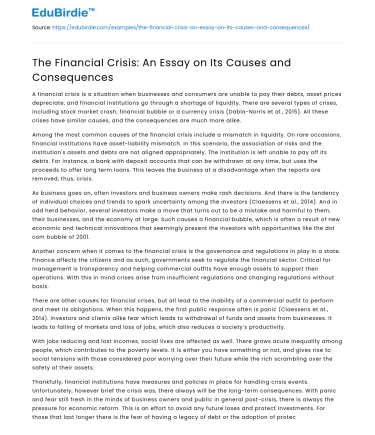A financial crisis is a situation when businesses and consumers are unable to pay their debts, asset prices depreciate, and financial institutions go through a shortage of liquidity. There are several types of crises, including stock market crash, financial bubble or a currency crisis (Dabla-Norris et al., 2015). All these crises have similar causes, and the consequences are much more alike.
Among the most common causes of the financial crisis include a mismatch in liquidity. On rare occasions, financial institutions have asset-liability mismatch. In this scenario, the association of risks and the institution's assets and debts are not aligned appropriately. The institution is left unable to pay off its debts. For instance, a bank with deposit accounts that can be withdrawn at any time, but uses the proceeds to offer long term loans. This leaves the business at a disadvantage when the reports are removed, thus, crisis.
Save your time!
We can take care of your essay
- Proper editing and formatting
- Free revision, title page, and bibliography
- Flexible prices and money-back guarantee
As business goes on, often investors and business owners make rash decisions. And there is the tendency of individual choices and trends to spark uncertainty among the investors (Claessens et al., 2014). And in odd herd behavior, several investors make a move that turns out to be a mistake and harmful to them, their businesses, and the economy at large. Such causes a financial bubble, which is often a result of new economic and technical innovations that seemingly present the investors with opportunities like the dot com bubble of 2001.
Another concern when it comes to the financial crisis is the governance and regulations in play in a state. Finance affects the citizens and as such, governments seek to regulate the financial sector. Critical for management is transparency and helping commercial outfits have enough assets to support their operations. With this in mind crises arise from insufficient regulations and changing regulations without basis.
There are other causes for financial crises, but all lead to the inability of a commercial outfit to perform and meet its obligations. When this happens, the first public response often is panic (Claessens et al., 2014). Investors and clients alike fear which leads to withdrawal of funds and assets from businesses. It leads to falling of markets and loss of jobs, which also reduces a society’s productivity.
With jobs reducing and lost incomes, social lives are affected as well. There grows acute inequality among people, which contributes to the poverty levels. It is either you have something or not, and gives rise to social tensions with those considered poor worrying over their future while the rich scrambling over the safety of their assets.
Thankfully, financial institutions have measures and policies in place for handling crisis events. Unfortunately, however brief the crisis was, there always will be the long-term consequences. With panic and fear still fresh in the minds of business owners and public in general post-crisis, there is always the pressure for economic reform. This is an effort to avoid any future loses and protect investments. For those that last longer there is the fear of having a legacy of debt or the adoption of protectionism which limits the economic growth and development of a nation (Dabla-Norris et al., 2015).






 Stuck on your essay?
Stuck on your essay?

